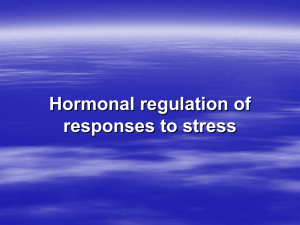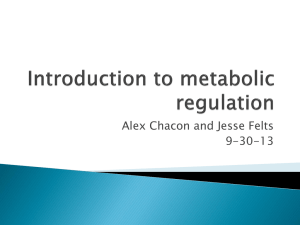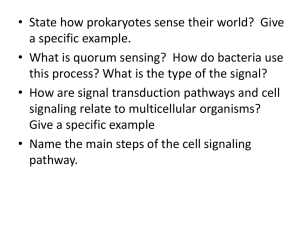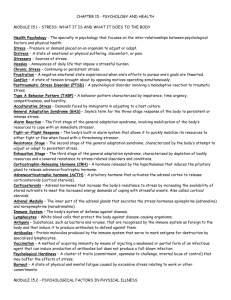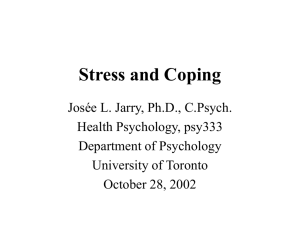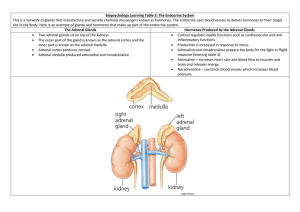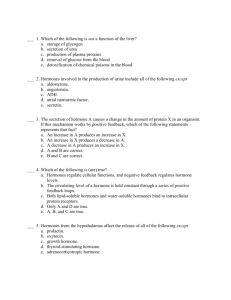Stress - Stanyer Stanyer
advertisement
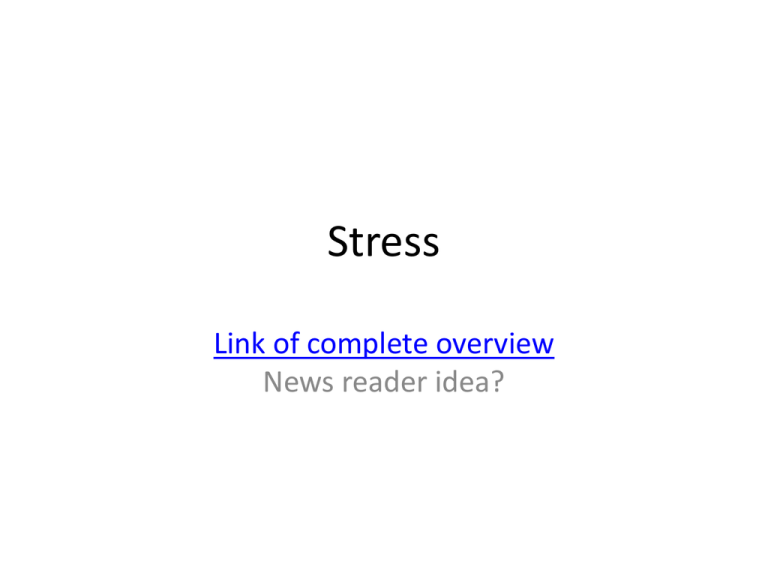
Stress Link of complete overview News reader idea? Exam question. • Explain what is meant by stress. • Stress is experienced when there is a difference between the perceived demands of a situation and an individual’s perceived ability to cope with that situation. The Syllabus Stress as a bodily response The body’s response to stress, including the pituitary-adrenal system and the sympathomedullary pathway in outline Stress-related illness and the immune system. Words • Stress = 1. stress response: Selye (rats and injections/individual differences) 2. Stimuli: Can be defined as stressful eg: Death. 3. Transactional Model: Cox and Mackay. Key process is appraisal: 4. This is split in 2 parts: 1. 2. Primary appraisal Secondary appraisal Transactional model • Primary and Secondary appraisal: ‘When an imbalance or discrepancy exists between perceived demands and perceived coping resources then a state of stress exists’ Diagram of Transactional Model explaining Primary and secondary. What is good! Transaction model takes into account individual differences eg: spiders. Stressor: a stimulus or situation imposing demands on an individual. Good So as well as physiological responses it takes into account reactions such as emotional anxiety or depression. Physiological Response Neuron Cells specialised to conduct electrical impulses (nervous system). Action potential = Electrical activity (nerve impulses). Everything is this ? This begins on the dendrites and travel along the axon to the synapses. Watch a video Synapse Synapse • All or none – A threshold must be reached for it to fire. • Limited number of Neurotransmitters and associated receptors. Synapses can be defined by the neurotransmitter they release. – GABA synaptic neurotransmitter involved in the action of anti-anxiety drugs. – Dopamine synaptic neurotransmitter involved in the action of antipsychotic drugs – Noradrenaline hormone released from adrenal medulla (also a neurotransmitter) acts on heart and circulatory system. – Serotonin synaptic neurotransmitter involved in the action of antidepressant drugs Nervous system Sensory pathways: sensory receptors to brain (not eyes or ears) Motor pathways: brain control movement The autonomic Nervous System • Located in the brainstem part of the Peripheral nervous system controls such things as heart rate, temperature and blood pressure. Central to homeostasis. • ANS has two parts which are usually in balance. – Sympathetic branch: arousal or dominance leads to increase heart rate and blood pressure. – Parasympathetic branch: Physiological calm – Note the Hypothalamus activates the sympathetic branch of ANS if in a dangerous or threatening perceived situation Sympathomedullary Pathway • The hypothalamus activates the adrenal medulla. The adrenal medulla is part of the autonomic nervous system (ANS). • The ANS is the part of the peripheral nervous system that acts as a control system, maintaining homeostasis in the body. These activities are generally performed without conscious control. Sympathomedullary Pathway • The adrenal medulla secretes the hormone adrenaline. This hormone gets the body ready for a fight or flight response. Physiological reaction includes increased heart rate. • Adrenaline lead to the arousal of the sympathetic nervous system and reduced activity in the parasympathetic nervous system. Sympathomedullary Pathway • Adrenaline creates changes in the body such as decreases (in digestion) and increases (sweating, increased pulse and blood pressure). • Once the ‘threat’ is over the parasympathetic branch takes control and brings the body back into a balanced state. Sympathomedullary Pathway • No ill effects are experienced from the shortterm response to stress and it further has survival value in an evolutionary context. Knowledge of main features of Sympathomedullary pathway Main features of the Sympathomedullary pathway are that the hypothalamus activates the sympathetic nervous system, which then stimulates the adrenal medulla to release the hormones adrenaline and noradrenaline into the bloodstream. This gets the body ready for fight-or-flight, eg increase blood pressure and heart rate. Pituitary-Adrenal System • The Hypothalamic Pituitary-Adrenal (HPA) System • The stressor activates the Hypothalamic Pituitary Axis • The hypothalamus stimulates the pituitary gland • The pituitary gland secretes adrenocorticotropic hormone (ACTH) • ACTH stimulates the adrenal glands to produce the hormone corticosteroid • Cortisol enables the body to maintain steady supplies of blood sugar • Adequate and steady blood sugar levels help person to cope with prolonged stressor, and helps the body to return to normal • The adrenal cortex releases stress hormones called cortisol. This have a number of functions including releasing stored glucose from the liver (for energy) and controlling swelling after injury. The immune system is suppressed while this happens. Knowledge of main features of pituitary-adrenal system • Main features of pituitary-adrenal system are that the hypothalamus communicates with the pituitary gland causing it to release ACTH. This hormone is then detected in the bloodstream by the adrenal cortex, which then releases corticosteroids such as cortisol and corticosterone. The corticosteroids have a range of effects such as causing the liver to release glucose. Evaluation • Strengths: • Measuring stress hormones gives an objective measure of stress. • Fight/flight response can be seen in all mammals in response to threats. • Weakness: • There is considerable variation in level and type of hormones released by different people and in response to different stressors – not a simple physiological process. • People without adrenal glands need hormonal supplements to survive stress. • Symington (1955) found that conscious dying patients showed different stress reactions to unconscious ones. Suggests that psychological factors play a role. Video review The body’s response to stress, including the pituitary-adrenal system and the sympathomedullary pathway in outline Selye again! The General Adaptation Syndrome (GAS) • Alarm . Prepares you to respond to environmental demands. The HPA system is activated: the sympathetic branch of the ANS is aroused and ACTH and adrenal hormones are released in readiness for fight or flight. • Resistance. If the stressor persists, the body adapts by returning to a normal level of functioning while coping with the stressor. Hormone production is maintained but at lower levels. • Exhaustion. Eventually the body’s resources are depleted. Adrenal glands are not functioning, leading to low blood sugars and various psychosomatic disorders such as ulcers. • GAS – too many hormones
